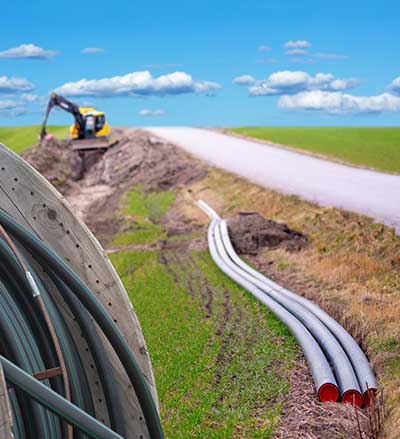ASCE ESTIMATES
n/a
Current Grade
n/a
Trend
n/a
Funding needed to raise to a "B" Grade

Current Grade
Trend
Funding needed to raise to a "B" Grade

The newest form of physical infrastructure we consider also attracts strong bipartisan support for new investments. Democrats and Republicans agree that the accessibility of high-speed internet connections for homes and businesses is increasingly important. Because both rural areas and lower income urban areas are underserved, broadband tends to bridge the usual partisan divides.
The country’s broadband infrastructure made it into the ASCE Report Card for the first time in 2021. Because the category is so new they did not have the same metrics and comparisons as they do for other kinds of infrastructure. Consequently, they did not give it a grade or estimate how much more funding is needed. The report concluded that “American’s reliance on fast internet is only forecasted to grow in coming years.”
President Biden and Senate Republicans not only agree that broadband deserves significant new funding, they also now agree on just how much more. The American Jobs Plan originally called for $10 billion in new broadband spending per year but reduced it to $8.1 billion to match Senate Republicans’ plan. Because the Common Sense Coalition plan that President Biden now supports calls for spending the same total amount over the shorter five year time period, that plan works out to $13 billion each year in new broadband funding. The Problem Solvers Caucus calls for $5.6 billion per year in new spending.
While the pandemic has created questions about whether demand for various types of transportation infrastructure will be reduced long-term by our experience with remote work, it highlighted for Democrats and Republicans alike how critical the infrastructure is that provides high-speed internet connections. Even before the pandemic, the importance of broadband was increasing rapidly, they observe. Economically, broadband provides access to the increasingly wide range of opportunities for remote work and can make the difference in businesses’ decisions about where to locate. Broadband was also already providing access to an exploding range of remote learning resources, supporters note. Increasingly, broadband has been facilitating access to healthcare delivery, including through telemedicine. The pandemic significantly accelerated all these developments, advocates observe.
Supporters argue that investing significantly more in high-speed internet connectivity today is akin to investing in rural electrification in the 1930’s or the interstate highway system in the 1950’s. Proponents argue that this investment will fundamentally make our economy and society more efficient and effective.
Supporters also argue that significant new investments in broadband will help our nation live up to its ideal of equal opportunity for all by powerfully addressing economic, educational, and health inequities. Underserved communities are found in both rural and distressed urban areas. Access to greater economic and educational opportunities, and to healthcare, are most profoundly needed in these areas of our country, supporters argue.
Some argue that the free market has already provided high-speed internet connections everywhere that it is cost-effective to do so. Where that investment would make a strong economic return, public utilities and other for-profit companies have already built out the necessary infrastructure. Extending broadband where it currently is not available, opponents argue, will be prohibitively expensive and bring benefits to fewer people.
The National Association of Counties (NACo) found that in 2020 65% of counties had average connection speeds slower than the definition of broadband. NACo found that slow connections were particularly common in less populated counties. According to the Center for Public Integrity, households with incomes over $80,700 are five times more likely to have access to broadband than households with less than $34,800 in income.